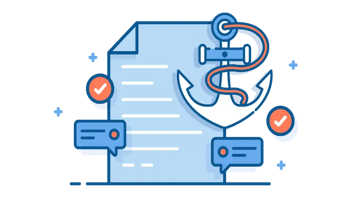如果你向许多公司询问他们的内容战略,他们中的大多数人都会告诉你关于新内容创作的情况。也许他们会提到通过监测内容的表现来了解未来几个月的编辑日历应包括哪些内容。最好的网络营销人员更清楚这一点。他们了解审视过去内容的重要性,从而调整内容以提高未来的效果。


内容审核是成功实施内容营销的关键因素。它们是快速提高网站流量的有力方法。如果你的网站有 3-5 年的历史,有定期的内容生产,并且从未进行过内容审核,那么当你进行第一次审核和改进计划时,你应该预期你的有机流量会增加 50-100% 或更多。
从技术角度看,如果你有很多过时的、无法正常运行的网页,谷歌机器人的抓取效率就会受到严重影响。如果需要抓取 1,000 个 URL 才能找到 100 个好的 URL,那么它们就会注意到这一点,以后就不会再花那么多时间抓取你的内容了。
从营销角度来看,您的内容代表着您的品牌。向受众维护、更新和改进您的内容,可以让访客和客户将您视为行业权威。通过优化和整理现有内容,可以明确主题重点,便于发现,并确保为用户提供价值。
定期维护内容不仅值得,而且是确保您的内容为您服务的必要工作。
在进行内容审核时,我们将内容元素分为三类:
-
良好:最能产生流量、转化率最高、链接和共享的内容。
-
改进: 产生的效果低于平均水平,但涵盖相关子主题的内容。
-
删除: 不产生投资回报率的内容,涵盖的主题/子主题不再与业务相关。
让我们来谈谈内容审计将如何解决这些问题。
完成基本内容审核的步骤:
1.确定您对内容的要求
明确您希望通过内容达到的主要指标。常见的目标包括网站流量、反向链接、社交分享、转化率、销售额和业务增长。网站的每一个页面都应至少为其中的一个目标做出贡献,任何不能促进其中至少一个目标的页面都会被删除。
像 "关于我们 "或 "联系我们 "这样的必填页面是例外。您可以对这些页面进行改进(元描述、URL slugs 等),但它们不属于整体内容分析/审核的范围。
2.收集所有内容
首先找到所有网站页面。您可以从网站后台或网站地图中提取这些内容。根据您使用的内容管理系统,这可以像将网页导出到电子表格一样简单。也可以从Google Analytics数据、Google Search Console 或使用所选工具进行的全面抓取中获取 URL。将这些信息放在电子表格中,其中的栏目包括 URL、页面标题、页面类型(如博客或着陆页)和指标(如月流量、反向链接、分享和转化率)。
3.对内容进行分类:良好、需要改进和删除
注意你过去一年的流量、反向链接和转化率都来自哪里。使用 BuzzSumo 等工具查找哪些网页在社交媒体上获得了关注,以及您的内容的反向链接在哪里。Google Analytics 和 Google Search Console 可以显示单个 URL 的流量。
结果高于平均值(或定义的阈值)的页面将被列入 "好 "页面。任何指标结果低于平均水平的页面都将被列入 "改进 "堆。指标结果为零的页面将被 "删除"。
在评估哪些需要保留、哪些需要改进、哪些需要删除时,您需要提出以下问题。
-
是否值得人们花费时间? 是否有帮助、信息量大或娱乐性强?它能回答问题、帮助解决问题或让读者感兴趣吗?
-
它对我们公司有价值吗?是否能赢得有机排名、流量或反向链接?是否有助于推动转化,从而提供商业价值?是否有助于建立品牌或有效树立权威?是否涵盖了您的主题集群中的关键子主题?
-
是否与我们的工作相关?除极少数例外情况外,没有理由保留至少与您的网站、行业和客户不密切相关的内容。
-
重复的内容对任何人都没有帮助,而且会堵塞网站。 如果你的内容在其他地方已经得到了更好的处理,那么就需要将其与效果更好的内容资产合并,或者进行修剪。

4.优化和修改内容
既然已经对内容进行了分类,那么就应该对其进行改进或删除。这些改进可以来自目标定位、写作和语法。确保您的内容有明确的观点、针对特定主题并正确使用术语。然后,添加任何您认为需要的技术改进,如相关内部链接、元描述或 alt 文本。创建和拥有高质量的内容是关键!
评估那些不需要明显修正的帖子,通过重新利用和更新它们来创造常青内容,从而获得更多价值。
在确保 "良好 "页面不需要更新或已经更新后,继续更新 "改进 "页面。你可能需要在这里花费大部分时间。这些页面已经显示出了前景,因此要密切关注,你会找到让它们表现更好的方法。
提升内容审核以最大限度地提高网站转化率涉及到一个整体的方法。深入研究视频、断链、内部链接建设、页面搜索引擎优化、CTA 和表单等关键要素:
-
视频: 评估视频在网站上的存在和表现,考虑查看次数、观看时间和用户参与度等指标。确保视频符合您的品牌,为受众提供价值,提升整体用户体验。优化视频质量,提供无缝、愉悦的观看体验,提升用户的好感度。考虑在相关内容中战略性地放置视频,以最大限度地提高可见度和影响力。
-
断开链接: 使用 Google Search Console 或在线链接检查器等工具及时发现并纠正断开的 链接。了解断链对用户体验和搜索引擎优化的潜在影响,强调维护的重要性。修复破损链接或将其重定向到相关内容,以保持无缝浏览体验。安排定期检查,确保链接的持续完整性和顺畅的用户体验。
-
内部链接建设:在内容中结合上下文整合内部链接,引导用户浏览相关信息。通过结构合理的内部链接建立信息层次,帮助内容的可发现性。使用描述性锚文本,加深用户理解并鼓励点击。确保内部链接的多样性,以全面覆盖整个网站。通过战略性地放置内部链接,为用户寻求更多信息提供便捷的导航。
-
页面搜索引擎优化: 确保页面针对相关关键词进行优化,提高搜索引擎的可见度。优化元标题和描述,提高点击率,并提供简洁的内容摘要。利用标题标签为用户和搜索引擎构建内容结构,帮助内容分层。确保响应速度和跨设备的无缝体验,满足不同用户的偏好。优化页面速度,以获得更好的用户体验并提高搜索引擎排名。
-
行动呼吁 (CTA): 战略性地定位CTA,吸引用户注意力,引导他们采取所需的行动。在 CTA 中明确阐述价值主张,确保用户了解采取建议行动的好处。利用各种 CTA,包括按钮、表单和链接,满足不同用户的偏好。将 CTA 与转换目标(无论是购买、注册还是下载)相一致,以推动有针对性的行动。对不同的 CTA 进行 A/B 测试,找出最有效的 CTA,并根据用户反应改进方法。
-
表单: 简化表单,提供友好的用户体验,减少摩擦,鼓励完成。确保表单字段与所需信息相关,有效收集有价值的数据。对较长的表单实施进度指标,让用户在整个过程中了解情况并参与其中。提供清晰的错误信息和验证,防止用户产生挫败感,确保数据提交准确无误。将表单与客户关系管理或电子邮件营销工具整合,以实现高效的潜在客户管理,促进无缝的后续流程。
例如,一个页面的流量低于平均水平。您可以添加外链和包含多个关键词的附加部分。尝试从一个表现较好的页面链接到它,并对一个页面进行修改,使其表现更好。
删除删除堆中的所有内容,将 URL 重定向到博客主页或相关的登陆页面。
5.至少每年进行一次内容审核
随着你不断剔除低效内容,内容审核过程将变得越来越容易。有了现有内容的数据库,监控更新和修订的影响就变得至关重要。每 6-12 个月留出时间重新评估内容,并为创建新内容和维护现有内容分配预算。请记住,搜索引擎更青睐条理清晰、有价值的网站。如果内容审核没有立即见效,也不要气馁。谷歌需要时间来认可和奖励您的辛勤工作。












发表评论